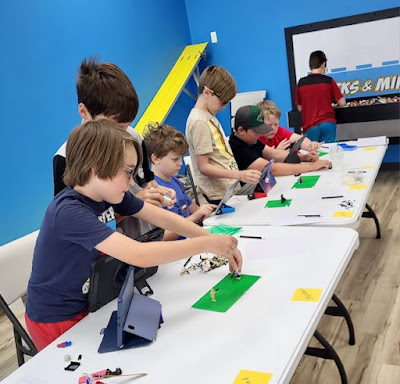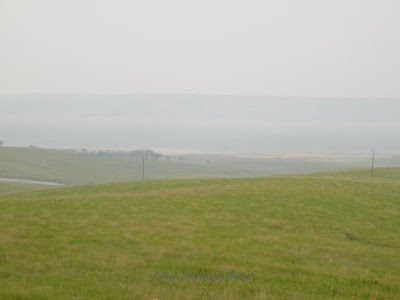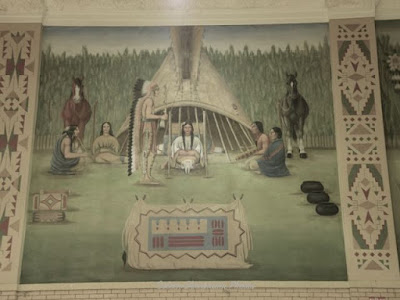While in Mobridge looking for answers, I also stopped at the Scherr-Howe Event Center. It had been MANY years since I entered the Mobridge Auditorium that hosted basketball games when I was in high school, and still does. A friend's comments on Facebook earlier this summer reminded me of the significance of the building and thus my visit.
The Scherr-Howe Event Center (Mobridge City Auditorium) is a public building that has been on the National Historic Registry since 1986. It was built as a WPA project in the 1930s and houses 10 early murals from renowned Native American artist, Oscar Howe. Howe painted the murals in the 1942, starting on April 18 and ending on June 22. On June 5, Howe was inducted into the US Army at Fort Snelling, but he received a 14 day furlough to finish the project. The murals were restored in 2014.
The event center has a beautiful wood floor basketball court. But I was there to see the 10 mural painted by Oscar Howe.
Victory Dance
This dance was performed after a successful military campaign, such as Little Big Horn in the summer of 1876. The sounds of the drums and cries of the victorious war party were celebrated in a spirited manner, along with a social feast to recognize the bravery of the warriors.
Hunkapi Ceremony
The hunkapi ceremony was the process by which individual persons and their families were joined together as family with other individual persons and their families. The ceremony formally created new extended families.
Courtship and Marriage
The mural titled Courtship and Marriage depicts the customs of a proper way of traditional marriage in Lakota and Dakota culture. The proper way of traditional marriage was a “bought” marriage, a way of mutual agreement. In this arrangement a woman and a man formed a union of engagement and marriage through the needs of their respective families.
A few years after painting this mural in Mobridge, Howe met his future wife, Adelheid “Heidi” (Hampel) Howe, at her father’s clothing store in Biedenkopf, Germany, during a period of rest and relaxation from the Army unit during the Second World War. Howe courted Miss Hampel for two years from 1945 to 1947 through letters and his promise of love for a lifetime until he was able to secure her agreement to come to the United States as a German war bride. Miss Hampel agreed to this arrangement, and the two were married at the Cook County Courthouse in Chicago, Illinois, on July 22, 1947. The couple remained married until Oscar Howe’s death on October 7, 1983.
Sun Dance
The ceremony is often considered the most important rite of the Lakota and Dakota people. The ceremony is held during the summer when the moon is full and when the sun is the highest and the days are the hottest. During the ceremony, dancers pledged to make offerings of their flesh to fulfill personal vows, to heal the sick and wounded, and to give strengthen to the people and the Buffalo Nation (Pte Oyate).
White Buffalo Calf Woman and the Sacred Buffalo Calf Pipe
The story of the White Buffalo Calf Woman and the Sacred Buffalo Calf Pipe has multiple versions. Stories, by their very nature, change and evolve over time. The central meaning of a story—the heart of the message—remains unchanged but stories vary according to the storyteller, the audience, or perhaps even the time of the year a story is told.
Vision Quest
In the mural Oscar Howe illustrates a man standing on a hilltop with his back facing the Missouri River in the background. During the course of the vision quest as depicted by the artist, the person promises to remain isolated on a hill, fasting without food or water, for one to four days with a blanket and a tobacco pipe.
Fool Soldiers Rescue
This incident involved Oscar Howe's grandfather, Don't Know How, and other relatives who helped several women and children escape capture during the Dakota Conflict. The Fool Soldiers were a group of young Teton and Yanktonal men dedicated to peace, non-violence, and helping people. The soldiers located where eight captives were being held at the mouth of the Grand River near present day Mobridge. The Fool Soldiers used their personal belongings to bargain for the release of the captives and guided them to Fort Pierre.
Christian Prayer Service
The priest featured in the mural, Father Pierre-Jean DeSmet, devoted much of his life to the spread of Christianity amongst the Lakota and Dakota people. Born in Belgium, DeSmet lived a pious life dedicated to the teaching of the Catholic doctrine after his accession to priesthood in the Roman Catholic faith. Father DeSmet spent much of his life spreading the word of God among Native American communities across the plains and caring for the sick and infirm during a period of great change as the cultures of indigenous peoples and the settlers and pioneers of the east encountered one another.
Treaty Making
In the year 1889 which coincides with the division of the Dakota Territory in North and South Dakota, the Great Sioux Reservation was divided into smaller reservations that reflect much of the remaining Sioux land base as it stands today. Today there are nine federally recognized tribes, or Native nations, in South Dakota: Oglala Lakota (Pine Ridge), Sicangu Lakota (Rosebud), Kul Wicasa Oyate (Lower Brule), Crow Creek Sioux, Yankton Sioux, Flandreau Santee, Sisseton-Wahpeton Oyate, Cheyenne River, and Standing Rock.
Sacajawea and Lewis and Clark Expedition
The mural featuring Sacajawea and her cradled infant son, Jean Baptiste Charbonneau, with the explorers Meriwether Lewis and William Clark is an iconic image in the story of the American s illustrative scene on the banks of the Missouri River.
More information about each mural can be found at
Oscar Howe Tour, under the title
Mobridge Murals
I admit I knew very little about South Dakota's native artist, Oscar Howe. I guess he wasn't all that famous when I was taking art appreciation classes in college. This article from the Aberdeen American News gave me the background I needed to appreciate him and his art.
Born on the Crow Creek Indian Reservation in 1915, Howe attended elementary school at the Pierre Indian School, a residential or boarding school for Native American children. He was diagnosed with tuberculosis at age 19 and relocated to Santa Fe, N.M., to recuperate.
After he recovered, he was one of 50 students selected to attend the prestigious Santa Fe Indian Art School. After his formal training, Howe was hired in the early 1940s to paint 10 murals in a new auditorium in Mobridge. Each panel that he painted was 16-by-20 feet.
He was then drafted into the U.S. Army during World War II and served in North Africa, Italy, France and Germany. While he was stationed in Germany, he met his future wife, Heidi. After the war, Howe won the grand prize, including a cash award, at the Philbrook Art Center in Oklahoma for his painting “Dakota Duck Hunt.” In 1947, he used his prize money to buy a plane ticket for Heidi to fly to the United States, and they were married that year.
He was a book illustrator for “North American Indian Costumes” and “Legends of the Mighty Sioux.” Howe was also the lead designer for the World’s Only Corn Palace murals in Mitchell for 23 years. He taught at Pierre High School and, in 1957, became artist-in-residence at the University of South Dakota. In 1960, he was named artist laureate of South Dakota. He retired from USD in 1980.
Howe left a significant and lasting impression on the art world. He exhibited in more than 50 solo shows and, according to information from the University of South Dakota Art Galleries, “He was on the cutting edge of his generation in the exploration of ways to break out of the stereotypes imposed on Indian artists and to seek contemporary ways of communicating Native American values and ideas … (he) had a more abstract and personal way of painting … marked by bright color, dynamic motion and pristine line.”
According to the book “Native American Master Artist: Oscar Howe” he, “is one of the most recognized and respected Native American painters of our time.”
Howe’s work may be viewed in many different locations, including the USD Art Galleries in Vermillion; the South Dakota Art Museum in Brookings; Scherr-Howe Event Center in Mobridge; the Dakota Discovery Museum in Mitchell; the Joslyn Art Museum in Omaha, Neb.; the Philbrook Museum of Art in Tulsa, Okla.; and many others.
There is a display of his work at the South Dakota Art Museum in Brookings, June 10-September 17, 2023.
Dakota Modern: The Art of Oscar Howe The art on display will be much different from the murals he painted in 1942. Take the time to check it out. I know I will.

















































